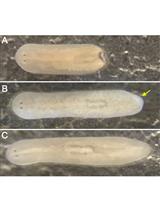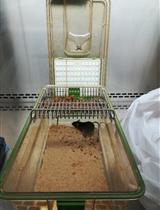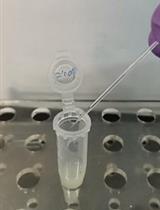- EN - English
- CN - 中文
Measurement of Respiration Rate in Live Caenorhabditis elegans
秀丽隐杆线虫活体呼吸速率的测定
发布: 2019年05月20日第9卷第10期 DOI: 10.21769/BioProtoc.3243 浏览次数: 8906
评审: Manish ChamoliTugsan TezilAnonymous reviewer(s)
Abstract
Mitochondrial function and dysfunction are at the core of aging and involved in many age-dependent diseases. Rate of oxygen consumption is a measure of mitochondrial function and energy production rate. The nematode Caenorhabditis elegans (C. elegans) offers an opportunity to study “living” mitochondria without the need for mitochondrial extraction, purification and associated artifacts. Oxygen consumption rate (OCR) is traditionally measured using single-chamber Clark electrodes with or without the addition of metabolic modulators. More recently, multi-well oxygen electrodes with automated injection system have been developed to enable rapid measurement of OCR under different conditions. Here, we describe a detailed protocol that we have adapted from existing protocols to measure coupled and uncoupled mitochondrial respiration (with and without metabolic modulators) in live respiring nematodes using a Seahorse XFe96 extracellular flux analyzer. We present details on our protocol, including preparation of nematode culture, use of metabolic modulators, execution of Seahorse XF assay as well as post-experimental data analysis. As a reference, we provide results of a series of experiments in which the metabolic activity of N2 wild-type nematodes was compared to N2 nematode treated with paraquat, a compound that generates reactive oxygen species (ROS), thus causing oxidative damage and mitochondrial dysfunction. These data illustrate the kind of insights that can be obtained even using a low number of nematodes (10 animals only per well).
Keywords: C. elegans (秀丽隐杆线虫)Background
One key function of mitochondria is to produce adenosine triphosphate (ATP) via oxidative phosphorylation. Electrons are transferred along mitochondrial respiratory chain complexes with oxygen being the terminal electron acceptor (Voet et al., 2002). OCR is often used as proxy for energy production rate (Braeckman et al., 2002; Gruber et al., 2011; Fong et al., 2017). The development of multi-well oxygen electrodes with an automated injection system permits the study of up to 96 samples with automated addition of metabolic modulators during a single run. Due to the small volume of the chambers, OCR can also be established in live respiring C. elegans with only a small number of nematodes (10 animals per well), e.g., using the Seahorse XFe96 analyzer. Automated addition of mitochondrial uncoupler can be used to short-circuit mitochondrial membrane potential and accelerate transport of protons across the membrane thus permitting the observation of maximal respiratory capacity (Koopman et al., 2016; Fong et al., 2017; Huang and Lin, 2018). However, unlike in isolated cells, ATP synthase inhibitor does not have effect in C. elegans, at least in our case. Therefore, there is no measurement of ATP-linked respiration and proton leak, although others have suggested it may work in C. elegans but we cannot make this to work consistently (Luz et al., 2015). Temperature is another technical limitation in this assay as there is no temperature control in the Seahorse XF analyzer; the experiment has to be dependent on the environmental temperature where the XF analyzer is placed. Below, we will discuss details of the protocol used in our laboratory and also present our post-experimental data analysis and normalization workflow.
Materials and Reagents
- Pipette tips
- XFe96 sensor cartridges and tissue culture microplates (Agilent Technologies, Seahorse Bioscience, catalog number: 101085-004)
- 50 ml centrifuge tube (Greiner Bio-One, catalog number: 210261)
- Parafilm (Bemis, catalog number: HS234526C)
- C. elegans N2 Bristol (Caenorhabditis Genetics Center)
- OP50-1 E. coli bacteria (Caenorhabditis Genetics Center)
- Paraquat (Sigma-Aldrich, catalog number: 36541)
- Carbonyl cyanide 4-(trifluoromethoxy) phenylhydrazone (FCCP) (Sigma-Aldrich, catalog number: C2920)
- Sodium azide (Sigma-Aldrich, catalog number: C2002)
- Dimethyl Sulfoxide (DMSO) (Sigma-Aldrich, catalog number: D2650)
- XF calibrant (Agilent Technologies, Seahorse Bioscience, catalog number: 100840-000)
- XFe96 Extracellular Flux Assay Kit (Agilent Technologies, Seahorse Bioscience, catalog number: 101085-004)
- NaCl (Sigma-Aldrich, catalog number: S5886)
- Bacto agar (BD Biosciences, catalog number: 214010)
- Bacteriological peptone (Sigma-Aldrich, catalog number: 91249)
- MgSO4 (Sigma-Aldrich, catalog number: M2643)
- CaCl2 (Sigma-Aldrich, catalog number: C5670)
- Cholesterol (Sigma-Aldrich, catalog number: C8667)
- Streptomycin (Sigma-Aldrich, catalog number: S9137)
- K2HPO4 (Sigma-Aldrich, catalog number: P3786)
- KH2PO4 (Sigma-Aldrich, catalog number: P5655)
- Na2HPO4 (Sigma-Aldrich, catalog number: S7907)
- NaOH (Sigma-Aldrich, catalog number: S8045)
- Nematode growth medium (NGM) agar (see Recipes)
- M9 buffer (see Recipes)
- Hypochlorite solution for worm synchronization (see Recipes)
- 1 M KPO4 (see Recipes)
Equipment
- Extracellular Flux Analyzer (Agilent Technologies, Seahorse Bioscience, model: XFe96)
- Non-CO2 incubator (Aqualytic, model: TC445S)
Software
- Seahorse Wave controller software (Agilent Technologies, Seahorse Bioscience)
- Prism 8 (GraphPad Software, www.graphpad.com)
Procedure
文章信息
版权信息
© 2019 The Authors; exclusive licensee Bio-protocol LLC.
如何引用
Ng, L. F. and Gruber, J. (2019). Measurement of Respiration Rate in Live Caenorhabditis elegans. Bio-protocol 9(10): e3243. DOI: 10.21769/BioProtoc.3243.
分类
细胞生物学 > 模式生物培养 > 保存
您对这篇实验方法有问题吗?
在此处发布您的问题,我们将邀请本文作者来回答。同时,我们会将您的问题发布到Bio-protocol Exchange,以便寻求社区成员的帮助。
Share
Bluesky
X
Copy link













